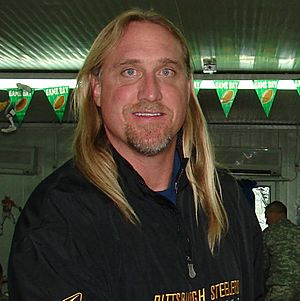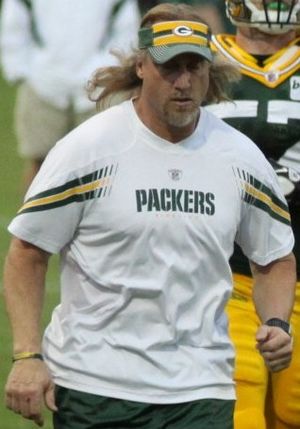Kevin Greene (American football) facts for kids

Greene in 2007
|
|||||||||||||
| No. 91 | |||||||||||||
|---|---|---|---|---|---|---|---|---|---|---|---|---|---|
| Position: | Defensive end, Outside linebacker |
||||||||||||
| Personal information | |||||||||||||
| Born: | July 31, 1962 Schenectady, New York, U.S. |
||||||||||||
| Died: | December 21, 2020 (aged 58) Destin, Florida, U.S. |
||||||||||||
| Height: | 6 ft 3 in (1.91 m) | ||||||||||||
| Weight: | 247 lb (112 kg) | ||||||||||||
| Career information | |||||||||||||
| High school: | Granite City South (Granite City, Illinois) | ||||||||||||
| College: | Auburn (1983–1984) | ||||||||||||
| NFL Draft: | 1985 / Round: 5 / Pick: 113 | ||||||||||||
| Career history | |||||||||||||
| As player: | |||||||||||||
|
|||||||||||||
| As coach: | |||||||||||||
|
|||||||||||||
| Career highlights and awards | |||||||||||||
|
|||||||||||||
| Career NFL statistics | |||||||||||||
|
|||||||||||||
| Player stats at PFR | |||||||||||||
|
Pro Football Hall of Fame
|
|||||||||||||
Kevin Darwin Greene (July 31, 1962 – December 21, 2020) was an American professional football player. He was a defensive end and outside linebacker in the National Football League (NFL). Greene played for the Los Angeles Rams, Pittsburgh Steelers, Carolina Panthers, and San Francisco 49ers from 1985 to 1999.
He was famous for his ability to "sack" the quarterback. He had 160 sacks in his career. This ranks him third among all-time NFL sack leaders. He was also named to the National Football League 1990s All-Decade Team. In 2016, he was chosen for the Pro Football Hall of Fame.
Greene played college football for the Auburn Tigers. During his NFL career, he was a three-time All-Pro player. He also led the league in sacks twice. After retiring as a player, he coached outside linebackers for the Green Bay Packers and the New York Jets.
Contents
Early Life and School Years
Kevin Greene was born on July 31, 1962, in Schenectady, New York. His father was an army colonel. This meant Kevin grew up as an "army brat," moving often. He started playing football on military bases.
His family lived in Mannheim, Germany for three years. In 1976, they settled in Granite City, Illinois. Greene played football and basketball at Granite City High School. He was also a high jumper on the track team. He graduated in 1980. In 1998, he was honored in the Granite City Sports Hall of Fame.
College Football Journey
After high school, Greene went to Auburn University. He joined the Reserve Officers' Training Corps (ROTC). He tried to join the Auburn Tigers football team as a punter in 1980. He didn't make the team then.
He tried again in 1983 and succeeded. In 1984, he won the Zeke Smith Award. This award is given to the Defensive Player of the Year. He had 69 tackles and 11 sacks in his senior year. He led the Southeastern Conference in sacks that year.
Greene studied criminal justice at Auburn. He also completed his ROTC training. He became a second lieutenant in the Alabama Army National Guard. Even after starting his NFL career, he continued his military training. He became a captain and a paratrooper.
NFL Career Highlights
Playing for the Los Angeles Rams
The Los Angeles Rams picked Kevin Greene in the fifth round of the 1985 NFL Draft. He played as a defensive end from 1985 to 1987. He was second on the team in sacks in 1986 and 1987. His first sack came in a playoff game against the Dallas Cowboys in 1985.
In 1988, Greene became a starting outside linebacker. He led the Rams with 16.5 sacks that year. This was the second-highest in the NFL. He had 4.5 sacks in one game against the San Francisco 49ers' Joe Montana. This win helped the Rams make the playoffs.
In 1989, Greene was named to the 1989 All-Pro Team and the Pro Bowl. He had 16.5 sacks again. He signed a new contract with the Rams in 1990. His 13 sacks in 1990 meant he had 46 sacks in three years. This was the most of any player in the NFL during that time.
In 1991, the Rams changed their defense. Greene's sack numbers went down. But he still made many tackles for loss. In 1992, he returned to his strong performance. He led the team in both tackles and sacks with 10 sacks.
Time with the Pittsburgh Steelers
In 1993, Greene joined the Pittsburgh Steelers. He signed a three-year contract. He returned to his favorite position, left outside linebacker. He had a great season with 12.5 sacks.
In 1994, Greene was chosen as an All-Pro player. He led the NFL in sacks with 14. He also went to the Pro Bowl again. In 1995, he made his third Pro Bowl. He had nine sacks and played in Super Bowl XXX. The Steelers lost that game to the Dallas Cowboys.
During his three years with the Steelers, their defense was very strong. They allowed very few rushing yards. They also led the NFL in sacks. Greene later said he had the "time of his life" playing for the Steelers.
Later Career Teams
In 1996, Greene signed with the Carolina Panthers. He helped them reach the NFC Championship Game. They lost to the Green Bay Packers. That year, Greene was named the NFC Linebacker of the Year. He also led the NFL in sacks for the second time with 14.5. He was an All-Pro and went to his fourth Pro Bowl.
After one season, he left the Panthers. He signed with the San Francisco 49ers in 1997. With the 49ers, Greene had 10.5 sacks. He was used as a player who would rush the passer on important downs.
In 1998, Greene returned to the Carolina Panthers. He had a great season with 15 sacks. This tied the Panthers' franchise record. He was named the NFC Linebacker of the Year by the NFL Players Association. He also made his fifth Pro Bowl.
Greene retired after the 1999 season. He had 12 sacks in his final year. He finished his career with 160 sacks. This made him the NFL's third all-time sack leader. He is also the all-time leader in sacks by a linebacker. He is one of only four players to lead the NFL in sacks in multiple seasons. Greene played in 228 games over 15 years. He is considered one of the greatest pass rushers ever.
In 2016, Kevin Greene was inducted into the Pro Football Hall of Fame.
Professional Wrestling Appearances
Kevin Greene also made appearances in professional wrestling. He worked with World Championship Wrestling (WCW) in the late 1990s. WCW brought in famous people like Greene to get more attention.
Greene first appeared in WCW in January 1996. He joined Hulk Hogan and Randy Savage at a wrestling event. He later wrestled his first match in June 1996. He teamed with former NFL player Steve McMichael. They faced Ric Flair and The Giant.
Greene returned to WCW in 1997. He teamed with Ric Flair and Roddy Piper. They faced the group called the New World Order. Greene won his match by pinning Syxx. The next month, he faced Steve McMichael. Greene won that match too.
His final appearances in WCW were in 1998. He faced The Giant in two matches. His football contracts later stopped him from wrestling. Greene wrestled a total of five matches. He shared the ring with many big names in wrestling. Many wrestlers praised his efforts and performances.
Coaching Career
In 2008, Greene worked as an assistant linebackers coach for the Pittsburgh Steelers. On January 26, 2009, he was hired by the Green Bay Packers. He became their outside linebackers coach. The Packers were changing their defensive style. Greene had played for the Packers' defensive coordinator, Dom Capers, before.
On February 6, 2011, the Packers won Super Bowl XLV. This was the first time Greene was part of an NFL championship team. He left the Packers in 2013 to coach high school football. He wanted to spend more time with his family.
In January 2017, the New York Jets hired Greene. He became their outside linebackers coach. He stayed with the Jets until 2019.
Personal Life and Passing
Kevin Greene was married to Tara. They had a son named Gavin and a daughter named Gabrielle.
Greene passed away on December 21, 2020. He was 58 years old. He died from a heart attack at his home in Destin, Florida.


